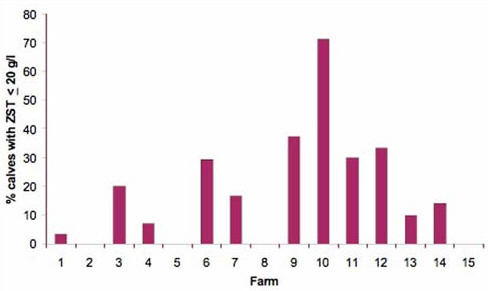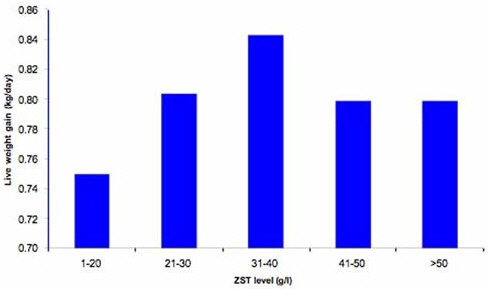



Developing Improved Calf Rearing Regimes – The Key to Profitable Beef and Dairy Production
By Lynne Dawson and Steven Morrison AFBI, Hillsborough. Successful calf rearing is critical to profitable dairy and beef production enterprises.Provision of adequate levels of nutrition (protein and energy) and suitable housing are fundamental to ensuring that animal health and welfare are optimised. Calf rearing is labour intensive with reports of up to 3 hours spent per day on calf care on dairy farms in Ireland.
 |
| Group feeding calves once per day can reduce labour costs by €2016 for 50-calf rearing system over a six week rearing period. |
Due to increasing herd size on many dairy farms and an increasing proportion of beef producers seeking non-farm sources of income, less labour is available for calf rearing. This could have implications for calf health and immunity, as less time is available for individual calf care. This article provides up-to-date information on research undertaken at AFBI Hillsborough (co-funded by AgriSearch and the Department of Agriculture and Rural Development (DARD)) into methodologies by which the problems of labour shortage, provision of adequate nutrition and calf health and welfare can be addressed.
Calf health and immunity
Calf mortality and morbidity represent a significant cost to the Northern Ireland cattle industry, both in terms of veterinary costs associated with treating affected animals, plus the losses associated with poor performance and death of animals. Mortality varies widely from farm to farm with reported values ranging from zero up to 13%. However, it is also important to note that the latter mortality values do not include calf mortality at birth which ranges from 3 to 14%.

Figure 1: Immune status of spring-born Holstein and beef x Holstein bull calves sourced from dairy farms in Northern Ireland
Insufficient intake of colostral immunoglobulins in the first 6 hours of birth has been highlighted as one of the main causes of calf health problems in the pre-weaning period. The immune status of calves can be identified by undertaking a Zinc Sulphate Turbidity Test (ZST) on a blood sample taken within 1 week of birth. Ideally calves should have a ZST level greater than 20 grams per litre to ensure optimum health and survival. The immune status of 150 bull calves, sourced from 12 dairy farms throughout Northern Ireland and transferred to AFBI, Hillsborough was evaluated in spring 2007. As indicated in Figure 1, 19% of all calves had ZST levels less than 20 grams per litre.
 Figure 2. Effect of farm of origin on proportion of calves with low ZST levels (less than 20 g per litre)
Figure 2. Effect of farm of origin on proportion of calves with low ZST levels (less than 20 g per litre) Results presented in Figure 2 demonstrate that management practices on the farm of origin have a significant effect on immune status, with some farms having a much greater proportion of calves with low ZST levels. For example, over 70% of the calves purchased from one farm had ZST levels less than 20 grams per litre whereas at the other extreme some farms had no calves with ZST levels less than 20 grams per litre. The importance of immune status has been highlighted by data produced by AFBI, Veterinary Sciences Division, where 37% of dead calves had no detectable colostrum immunity and 60% had Zinc Sulphate Turbidity (ZST) values less than 10 grams per litre. This is further supported by data presented in Figure 3, where calves with ZST levels less than 20 grams per litre had 7% lower live weight gains from birth to 9 months relative to those with ZST levels greater than 20 grams per litre.In monetary terms at 9 months of age, cattle which had ZST levels less than 20 grams per litre are worth €31 less than those with higher ZST levels (live weight difference at 9 months is 23 kg and price is €1.34 per kg).
 Figure 3. Relationship between calf immune status and performance up to 9 months of age
Figure 3. Relationship between calf immune status and performance up to 9 months of ageSummary
Adequate colostrum intake is essential - 10-15% of body weight (or 3 feeds of 1.5 litres) in the first 12 hours after birth to ensure optimum lifetime performance. Due to poorer performance, cattle which did not receive adequate colostrum at birth are worth up to €31 less at 9 months of age than calves which received adequate colostrum.
Labour inputs
Due to increasing herd size and increased number of part-time farmers, less labour is available on many farms for calf rearing. This could have implications for calf health and immunity, as less time is available to ensure that calves receive adequate colostrum.
Research has been undertaken at AFBI Hillsborough to evaluate mechanisms by which labour inputs and costs associated with rearing beef cross calves can be reduced. Over 2 years, a total of 260 February/March-born, beef cross dairy bull calves (Belgian Blue, Limousin, Aberdeen Angus and Holstein) were sourced from 12 dairy farms located throughout Northern Ireland. On arrival at Hillsborough, the calves were allocated to 2 rearing systems:
- Low Labour System - calves group - housed and fed once per day through a group feeder designed to feed 30 calves as shown in the attached photograph.
- Standard System - calves individually bucket fed twice per day.
Calves on the Low Labour System had lower live weight gains relative to those on the Standard System and weighed 10- 11 kg less at 3.5 and 9 months of age than those on the Standard system. In monetary terms (for a 50-calf rearing system, weaning calves after 6 weeks), this equated to the calves being worth €737 less at 9 months of age than those on the Standard System. However when labour inputs are considered, up to two-thirds less time was spent feeding calves on the Low Labour System relative to those on the Standard System. Assuming a labour cost of €16 per hour and a 6 week rearing period, this is equivalent to a reduction in labour cost of €2016 for a 50-calf rearing system over the 6 week period. On this basis the savings in labour costs in the Low Labour System more than compensated for the lower performance and consequently lower value of the animals. Research is continuing to investigate reasons for poorer growth rates with the Low Labour System.
Summary
While the value of calves on a Low Labour System was €737 for a group of 50 calves fed once per day over a 6 week rearing period) lower than those on a Standard System (calves individually fed twice per day) due to lower live weight gains, the reduction in labour costs of €2016 with the Low Labour System more than compensated for the poorer performance.
Feeding level and protein content of milk replacer
The current recommendations for the pre-weaned calf (up to 8 weeks of age) are to offer 500 grams per calf per day of a milk replacer containing 23% crude protein, together with access to ad libitum concentrates and water with the aim of achieving growth rates from 450 to 600 grams per day. However, research from the United States has questioned this approach of restricted feeding as the best method of achieving optimum calf growth and health in dairy bred heifers and there has been a move towards accelerated growth rates (up to 1000 grams per day) in the pre-weaning period. These higher growth rates can be achieved by feeding 900 to 1200 grams milk replacer per calf per day with an increased crude protein content (30%) to support the higher growth rates. However, with increasing milk replacer costs (currently priced at up to €2300 per tonne), it is important to evaluate if these higher levels of feeding and higher protein content are economical. A series of collaborative studies undertaken at AFBI Hillsborough and Teagasc, Grange have compared the performance of dairy-bred calves offered milk replacer containing 23% or 30% crude protein at two feeding levels (600 grams per day or 1200 grams per day).
Relative to calves offered 600 grams milk replacer per day, calves offered 1200 grams milk replacer per day grew significantly faster during the milk feeding period (birth to 8 weeks) although feed costs were increased by up to €36 per calf. However, differences in live weight and body size recorded at weaning (56 days) for calves on the higher level of milk replacer had disappeared by 6 months and there was no significant effect on first lactation milk performance. Increasing the crude protein content of the milk replacer increased feed costs by €7.85 per calf, but had no benefit on calf performance or first lactation milk yield.
The lack of a significant effect of feeding level or crude protein content of milk replacer on performance suggests that current recommendations (500 grams of milk replacer containing 23% crude protein per day) are appropriate for nutrition of dairy bred calves.
Target growth rates
From a review of research undertaken at AFBI, Hillsborough and other research centres, typical growth rates, in the period from birth to weaning, for dairy-bred calves offered milk replacer at levels of 450 to 650 grams per day range from 0.38 to 0.56 kg per day. Higher live weight gains (up to 0.9 kg per day) have been obtained in trials where calves are older at the commencement of the study (at least 2 weeks old) or are offered ad libitum access to whole milk. However, in view of the findings reported in the previous paragraph, there are no beneficial effects on lifetime performance through achieving high growth rates in the pre-weaning period.
On this basis, target growth rates in the period from birth to weaning should be in the range 0.45 to 0.60 kg per day.
Summary
- Up to 20% of calves from Northern Ireland dairy farms are not receiving sufficient colostrum (as indicated by Zinc Sulphate Turbidity test) which has serious implications on future health. It is critical to ensure that calves receive colostrum to 10-15% of body weight in the first 12 hours after birth.
- Labour costs associated with calf rearing can by reduced by up to €2016 over a 6 week rearing period by group feeding calves once per day (based on a 50 calf-rearing system).
- Increasing the crude protein content of milk replacer to 30% had no benefit on animal performance, but increased feed costs by €7.85 per calf.
- Increasing feeding level of milk replacer from 600 grams per day to 1200 grams per day increased feed costs by €33-36 per calf, increased calf performance up to weaning, but had no effect on first lactation milk yield of dairy heifers.
- Calves should be offered 500 to 600 grams of milk replacer containing 23% crude protein per head per day in the period from birth to weaning to achieve a target growth rate of 0.45 to 0.60 kg per day.
February 2008



